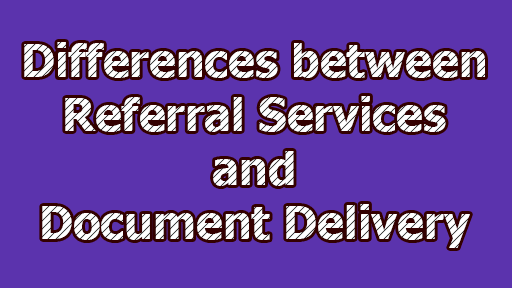Differences between Referral Services and Document Delivery:
Referral services and document delivery are two distinct services that serve different purposes within the context of information access and retrieval. While both services aim to facilitate the acquisition of information, they differ in terms of their focus, methods, and outcomes. Here are some of the key differences between referral services and document delivery:
| Referral Services | Document Delivery |
| 1. Focuses on directing users to relevant information sources or experts. | 1. Focuses on acquiring and delivering specific documents or information items. |
| 2. Assists users in identifying appropriate information sources, such as libraries, databases, or subject-specific repositories. | 2. Procures requested materials, including articles, books, reports, etc., from various sources. |
| 3. Helps users locate subject-matter experts who possess specialized knowledge in a particular field. | 3. Facilitates access to requested documents regardless of their physical or digital format. |
| 4. Provides guidance and recommendations on effective strategies for accessing information. | 4. Acts as an intermediary between users and the materials they need. |
| 5. Offers an advisory role by suggesting alternative sources or search techniques based on expertise. | 5. Bridges the gap between users and the desired documents or information items. |
| 6. Does not directly deliver documents or information to users. | 6. Delivers requested documents to users through physical or electronic means. |
| 7. Examples include reference librarians, research help desks, virtual reference services, and subject-specific information centers. | 7. Examples include ILLiad, RapidILL, and commercial document delivery companies like Reprints Desk. |
| 8. Focuses on directing users to appropriate resources for self-retrieval. | 8. Focuses on obtaining and delivering materials on behalf of users. |
| 9. Does not typically involve fees for the referral service itself. | 9. Usually involves fees for document acquisition, delivery, or copyright clearance. |
| 10. Helps users with information source identification and locating subject-matter experts. | 10. Requires access to sources or providers of requested documents to fulfill user needs. |
| 11. Does not require ownership or control of the requested documents. | 11. Requires access to materials from various sources to fulfill user requests. |
| 12. Aims to facilitate user autonomy in retrieving information by guiding them to the right sources. | 12. Aims to bridge the gap between users and documents by acquiring and delivering requested materials. |
| 13. Primarily focuses on the referral aspect of connecting users with appropriate resources. | 13. Primarily focuses on the document delivery aspect of obtaining and delivering requested materials. |
| 14. Provides advice and assistance throughout the information search process. | 14. Provides access to specific documents or information items requested by users. |
| 15. Supports users in locating information or expertise beyond the capabilities of their own institution or knowledge. | 15. Supports users in accessing documents that may not be available in their local library through interlibrary loan networks. |
In summary, referral services primarily focus on directing users to appropriate information sources or experts, providing guidance and recommendations, while document delivery services specialize in acquiring and delivering specific documents or information items requested by users. Referral services do not directly provide the requested materials, whereas document delivery services play a crucial role in obtaining and delivering the documents themselves.

Library Lecturer at Nurul Amin Degree College










